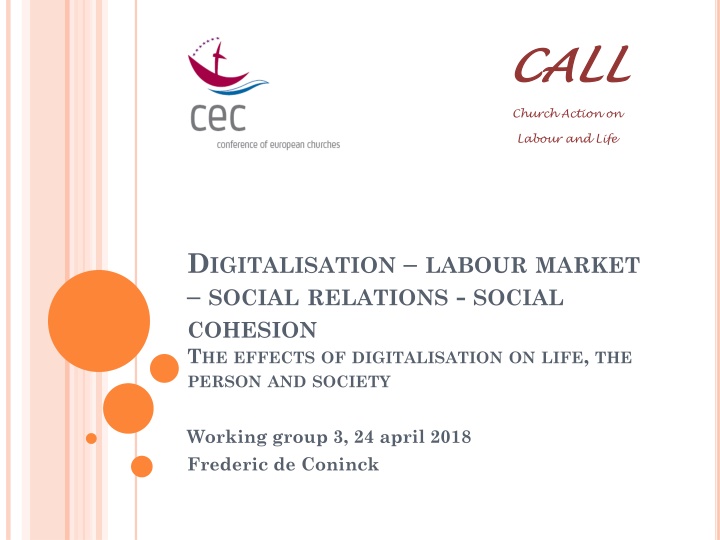
Impacts of Digitalisation on Labour Market: Job Polarisation and Social Effects
Explore the repercussions of digitalisation on the labour market, focusing on job polarisation and its social effects. Delve into the shifts in job dynamics, highlighting the creation and elimination of various job sectors due to technical innovations. Witness how digitalisation is reshaping the workforce landscape and affecting societal cohesion.
Download Presentation

Please find below an Image/Link to download the presentation.
The content on the website is provided AS IS for your information and personal use only. It may not be sold, licensed, or shared on other websites without obtaining consent from the author. If you encounter any issues during the download, it is possible that the publisher has removed the file from their server.
You are allowed to download the files provided on this website for personal or commercial use, subject to the condition that they are used lawfully. All files are the property of their respective owners.
The content on the website is provided AS IS for your information and personal use only. It may not be sold, licensed, or shared on other websites without obtaining consent from the author.
E N D
Presentation Transcript
CALL CALL Church Action on Labour and Life DIGITALISATION LABOUR MARKET SOCIAL RELATIONS - SOCIAL COHESION THE EFFECTS OF DIGITALISATION ON LIFE, THE PERSON AND SOCIETY Working group 3, 24 april 2018 Frederic de Coninck
WHO AM I? WHAT AM I SPEAKING ABOUT? A double training: civil engineering and sociology Ecole Nationale des Ponts et Chauss es (Paris) Organisational studies in companies and urban studies Three questions: The consequences of digitalisation in work situations The consequences of digitalisation in everyday life The links between work and non-work situations Digitalisation is not only the future. It s also the present and the recent past
OUTLINE Digitalisation and the labour market : job polarisation and it s social effects 1. Digitalisation and real work : a new kind of intensity of work and it s social effects 2. The hard question of the domestication of digitalised devices in everyday life : opportunities and threats 3.
DIGITALISATION AND THE LABOUR MARKET : JOB POLARISATION AND IT S SOCIAL EFFECTS
DIGITALISATION AND JOB POLARISATION Technical innovation has already killed a considerable number of jobs In France 5 millions in agriculture since 1950 mainly due to mechanisation In France 2 millions of non-skilled blue-collars since 1985 mainly due to automation (and only partially to offshoring) In France 400,000 white-collars since 1985 mainly due to office automation tools And is also creating a great number of jobs In France 3 millions of middle and top managers since 1985
DIGITALISATION AND JOB POLARISATION (ALREADY VISIBLE / EUROSTAT)
DIGITALISATION AND JOB POLARISATION (ALREADY VISIBLE / US CENSUS BUREAU) Non routine jobs include service and protection workers, such as waiters and security guards
DIGITALISATION AND JOB POLARISATION (NOW AT HAND, FRANCE LABOUR MINISTRY)
DIGITALISATION AND JOB POLARISATION (COMING EFFECTS) Less middle skill jobs More control and maintenance of automated systems Transforming professional activities: Image recognition in medicine Automated risk assessments in insurances Big data and new forms of marketing Remote working and co-working Etc. Maybe not less professionals but new profesionnalities The relevant competences will move very quickly
JOB POLARISATION AND POPULIST VOTES Main source of populist votes
DIGITALISATION AND CENTRALISATION OF DECISIONS INSIDE BIG COMPANIES Supply Chain Management and the development of Enterprise Resource Planning software, at the beginning of the 1990 s, has made it possible for big companies to change outsourcing strategies very quickly and frequently For people working in peripheral sites, including local top managers, it has been a large loss of autonomy The centre of the company asks for a lot of reporting, but does not report the logic of its decisions
DIGITALISATION, CONCENTRATION OF DECISIONS INSIDE COMPANIES AND IT S SOCIAL CONSEQUENCES This has consequences on the wage policies and on the concentration of wealth This has consequences on the loss of political power for local governments And again this feeds anger and the conviction that politicians don t do their job, which causes populist votes According to the libertarian ideology of Californian computer scientists, digitalisation was to promote equality and empowerment, but the reverse is happening
DIGITALISATION AND REAL WORK : A NEW KIND OF INTENSITY OF WORK AND IT S SOCIAL EFFECTS
DIGITALISATION AND NEW KINDS OF WORK INTENSITY Work shifts from direct action to action mediated by a digital interface (controlling a system, using data bases, receiving orders, etc.). That s true for blue-collars, white-collars and managers. And those interfaces exacerbate the difference between stipulated work and real work: they provoke a lot of discomfort People say they have to deal with contradictions in demands, frequent changes of orders, etc. And the more they deal with digital interfaces, the more disorganised is their work.
DIGITALISATION AND NEW KINDS OF WORK INTENSITY The communication tools and software improve far more quickly than optimisation software Too many information, not enough time for reflexivity and self optimisation Impossible to know if one is doing good job or not Many workers face directly clients with no more help than a distance connection to a digital base. They are supposed to deal with any situation, even the more complex or dramatic one
DIGITALISATION AND NEW FORMS OF WORK INTENSITY Since the EDI (1960 ), then MRP etc. digitalisation has been used to make more present and immediate (just-in-time) commercial demands A great amount of impersonal and irrational demands converge to any worker The short term overwhelms the long term It s easier to ask for something impossible if you are far from the worker and you do not directly confront him
WHAT WORKERS SAY ABOUT THE DISCOMFORT OF DIGITALISED WORK The more they use digital tools the more they say that : They suffer a skill gap for the job that is asked Some of their acquired skills are not used They receive contradictory orders They often have to urgently abandon a task They often have to hurry up They receive internal or external requests to satisfy immediately They suffer disturbing computer failures (Nathalie Greenan, Sylvie Hamon-Cholet, Frederic Moatty, Jeremie Rosanvallon, TIC et conditions de travail. Les enseignements de l'enquete COI. Rapport de recherche du CEE, 2012)
THE SOCIAL CONSEQUENCES OF THAT INTENSIFICATION OF WORK Many mental health problems : Burn-out, bore-out, brown-out, etc. Stress, anguish, trouble sleeping, digestive problems, etc. The danger of giving everything anytime, anyhow A pathology arising from inadequacy in a social context where success is attributed to, and expected of, the autonomous individual (Ehrenberg) Weakening of social ties
SOCIAL ISOLATION THROUGH REMOTE WORKING Remote co-working is not building a work collective or a community of affiliation Many surveys show that people who no longer meet one another suffer from isolation: they cannot speak with one another about little troubles The social danger of digitalisation : from autonomy as empowerment to autonomy as isolation and standing on its own
THE HARD QUESTION OF THE DOMESTICATION OF DIGITALISED DEVICES IN EVERYDAY LIFE : OPPORTUNITIES AND THREATS
THE THREAT OF ROBOTS THAT WOULD GOVERN US IS A BIT CONFUSING Let s not forget that machines have always been dangerous In Machines That Become Us: The Social Context of Personal Communication Technology (2002 !, James E. Katz ed.), Leslie Haddon shows that non domesticated devices are not adopted. So there are maybe more resistance possibilities to robots invasion that one can imagine But there are great inequalities in domestication capacities . The digitalisation of social practices is thus producing and elitist society 1. 2. 3.
ANY MACHINE DEMANDS LEGISLATIVE WORK Robots may happen to be dangerous but they are not alone in that case The first industrial machines were very dangerous and caused millions of deaths Cars (whether they are autonomous or not) are dangerous as well Even household appliances may cause accidents and, for this reason, they have to comply with strict regulations When weapons (whether they are autonomous or not) are poorly regulated, they give rise to carnages The quickness of innovation is a major challenge today: regulation has to be quick as well
DOMESTICATION I have seen an incredible number of failures in the implementation of technical innovations: for instance in home automation Must of them failed because they were not user friendly People want to make a machine part of their natural practices like an animal they want to domesticate. Otherwise they reject that machine For instance very few people program a programmable thermostat (which is a very simple device) because the interface is ill- conceived
DOMESTICATION The difficulties of domestication is as well a source of resistance to what innovators propose, and of inequalities For instance the brick and mortar shops tend to be complementary to online shops (less variety proposed locally, sellers less competent). If you are not able (or not willing) to buy something online, you will loose something Some administrative procedures become difficult if you do not use the Internet The way people use the advanced possibilities of a smartphone is very uneven Digitalisation is building an elitist society
DIGITALISATION IS ADAPTED TO (AND REINFORCES) TWO MAJOR SOCIAL CHANGES The strength of weak ties (Granovetter, 1973) 1. A redefinition of time and place of work 2. Information and Communication Technologies have been adopted because they were coherent with those trends
THE STRENGTH OF WEAK TIES In 1973 it was already obvious that traditional social ties were weakened (family, neighbourhood, church, etc.) The Granovetter article: weaker ties but more ties The incredible commercial success of mobile phones has been a surprise. Mobile phones made easy a nomad use of the phone that was increasing The digital social networks look like the Granovetter description But that strength has many limits
A REDEFINITION OF TIME AND PLACE OF WORK Interesting case of a domestication process: First the developing of emails, and remote communication tools, made it possible an invasion of work in the private sphere This proved to be very disturbing So some collective rules of functioning appeared, joined to family regulation Now the use of mobile phone by colleagues outside working hours is poorly seen; as well as sending business emails at night; and the out of office auto- reply messages are spreading But it is true that working time and place have become more scattered since the 1980s
ARE WE READY TO LIVE IN THE NETWORK SOCIETY? Where everyone has to cope with their own difficulties? Where some belong to a number of diverse networks, and others are rejected by most of them? Where it is becoming more and more important to be technically able to use a greater number of devices? A major issue: educational systems as well as regulatory authorities, are frequently overtaken by events



















